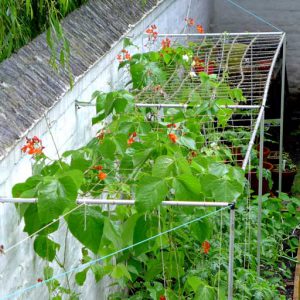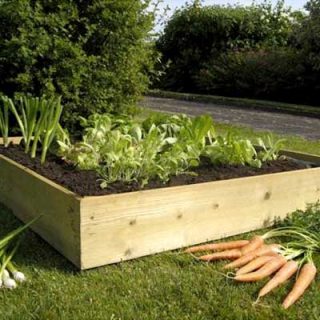
Organising what to grow in a raised bed is a balance between the exposure of the bed and choosing plants which are complimentary. The basic rule of “square foot planting,” one plant per square foot, is a good start. However, with using the elevational space, a lot more can be achieved.
The best way to make a raised bed super fertile if to feed it with homemade compost every year. This allows the gardener to be greedy and push in an extra crop at ground level. This year the bed is being planted with onions, garlic and shallots as an under-story for tomatoes and cucumbers later.
In previous years climbing beans have been planted extensively to grow over the raised bed protecting tomatoes from heavy rain (and tomato blight). This year beans will be planted elsewhere as they do not grow well in the same bed with onions and garlic. This is an experiment this year.
The overhead frame and netting over the raised bed are ideal from training climbers such as beans and cucumbers, and for providing support for tomatoes. These are a good combination together. In a garden free from slugs – if such a thing exists – it is possible to add salads and herbs to the ground level.
In damp and shaded conditions it is better to organise crops off the soil level, keeping the bottom area open and clear for airflow. Tomatoes, beans and cucumbers can be organised to make use of this middle space with the overhead covering providing some shade during extra warm spells.

The basic raised bed layout of tomatoes, beans and cucumbers works well in the limited conditions of a city garden. By substituting garlic and onions for beans this year, the aim is to extend the production period into the winter months and possibly deter the army of slugs and snails that live in the garden. Then maybe some salads and herbs can be added.












